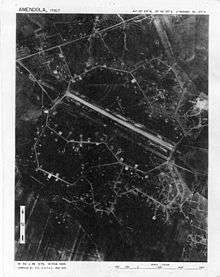Amendola Air Base
Amendola Air Base | |
|---|---|
|
Part of Italian Air Force Aeronautica Militare | |
| Province of Foggia, Italy | |
|
Alenia/Aermacchi/Embraer AMX at Amendola Air Base | |
 Amendola Air Base Location of Amendola Air Base, Italy | |
| Coordinates | 41°32′29″N 015°43′05″E / 41.54139°N 15.71806°E |
| Type | Military airfield |
| Site information | |
| Controlled by | Italian Air Force |
| Site history | |
| Built | 1941 |
| In use | 1941-1945; 1947-Present |
| Battles/wars |
|
| Airfield information | |||||||||||
|---|---|---|---|---|---|---|---|---|---|---|---|
| IATA: none – ICAO: LIBA | |||||||||||
| Summary | |||||||||||
| Elevation AMSL | 183 ft / 56 m | ||||||||||
| Runways | |||||||||||
| |||||||||||
Amendola Air Base (ICAO: LIBA) is a military air base of the Italian Air Force (Aeronautica Militare). It is the home of 32 Stormo Squadron, 28th Group, equipped with the AMX International AMX ground attack aircraft.[1]
Overview
Amendola Air Base is primarily a training base for pilots of the AMX International AMX ground attack aircraft. The It is the main base for training Italian Air Force AMX pilots. The 28th Group operates the training center for Italian Air Force MQ-1C and MQ-9A Predator UAVs. The 632d Squadron provides connections through the aircraft supplied (MB339) training, flight personnel under the 28th Group in order to ensure adequate training level on traditional piloted aircraft.[1]
Aircraft assigned to Amendola Air Base include the following:[1]
- AM-X, AMX-T Ground Attack Aircraft
- MQ and MQ-1C-9A Predator UAVs
- Aermacchi MB-339 (versions A and CD) trainers.
Amendola was also used operationally by NATO forces in 2011 as part of Operation Odyssey Dawn and Operation Unified Protector[2]
History
World War II
Amendola Airfield a pre-war Italian Air Force (Regia Aeronautica) facility, built about 1931. With the surrender of Fascist Italy to the Allies on 3 September 1943, the German Luftwaffe seized control of the field upon hearing of Italy's capitulation, and briefly used it as a combat airfield, however Allied forces seized control of the Tavoliere plain in late September/October and occupied the airfield.[3][4]

The United States Army Corps of Engineers rebuilt the facility into a heavy bomber-capable airfield. it had two 6,000' x 100' runways laid over Pierced Steel Planking, oriented 11/29. There were two perimeter tracks, and several other loop taxiways each containing about 100 aircraft parking hardstands. both of the double loop for bombers and single frying pan type for fighters. There may have been some temporary hangars and buildings, however it appears that personnel were quartered primarily in tents, and most aircraft maintenance took place in the open on hardstands. It also had a steel control tower.[4]
Operationally, Amendola became one of the largest USAAF bases in Italy. Its first use was by the Twelfth Air Force 57th Fighter Group, which operated three P-40 Warhawk squadrons from 27 October 1943. A second Twelfth Air Force Group, the 321st Bombardment Group moved in on 20 November 1943 with four B-25 Mitchell squadrons.[5]
In December 1943, Amendola was transferred to Fifteenth Air Force, which stationed two B-17 Flying Fortress heavy bombardment Groups at the field. The 321st moved out to Vincenzo Airfield and the 57th to Cercola Airfield by March 1944. These were replaced by the 2d Bombardment Group and 97th Bombardment Group, which moved to Italy from bases in Tunisia.[5]
After being part of the Army of Occupation in Italy after the war, the 2d Bombardment Group moved to Foggia Airfield in November 1945; the 97th moved to Marcianise Airfield in October, and by the end of 1945, the Americans had placed the airfield into an inactive status.[5]
Italian Air Force
On 1 February 1947 the vacant Amendola Airfield was turned over by the United States to the new eronautica Militare. The runway was lengthened for jet aircraft use, and its mission was to train jet pilots on the de Havilland Vampire and Lockheed T-33 Shooting Star. In 1953, night fighter training commenced with the de Havilland DH113s. The Fiat G.91 arrived in 1954 which was used for almost 30 years for advanced pilot training.[3]
32 Squadron (32 Stormo) arrived at the base in 1993 for operational use. It flew the twin-engine Fiat G.917 By 1995, all G.91d were retired and replaced by the modern AMX. With these aircraft, the squadron participated in 1997 and 1999 NATO missions over the former Yugoslavia. During the Kosovo war, operating from Amendola also Belgian and Dutch F-16 . In 2002, the Italian Air Force received their first MQ-9 Predator drones, which later together with the AMX fighter aircraft, were used in Afghanistan.[3]
Because of the pending in Amendola introduction of Lockheed Martin F-35 and in connection therewith preparations and rearrangements one of two formerly stationed here AMX squadrons (13 Gruppo) was dissolved in December 2013.[3]
See also
References
![]() This article incorporates public domain material from the Air Force Historical Research Agency website http://www.afhra.af.mil/.
This article incorporates public domain material from the Air Force Historical Research Agency website http://www.afhra.af.mil/.
- 1 2 3 Official website 32 Stormo
- ↑ The Italian Air Force in Operation Unified Protector
- 1 2 3 4 German Wikipedia Militärflugplatz Amendola
- 1 2 AFHRA Document 00245069 ARMY AIR FORCES ENGINEER COMMAND, MEDITERRANEAN THEATER OF OPERATIONS
- 1 2 3 Maurer, Maurer. Air Force Combat Units of World War II. Maxwell AFB, Alabama: Office of Air Force History, 1983. ISBN 0-89201-092-4.

.svg.png)